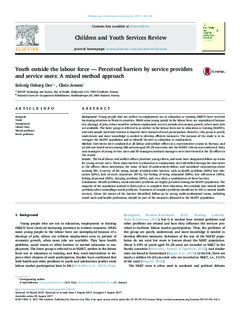| dc.description.abstract | Background Young people who are neither in employment nor in education or training (NEET) have received increasing attention in Western countries. While some young people in the labour force are unemployed because of a shortage of jobs, others would be without employment even in periods of economic growth, when more jobs are available. The latter group is referred to as neither in the labour force nor in education or training (NLFET), and such people need intervention to improve their chances of work participation. However, this group is poorly understood, and more knowledge is needed to develop efficient measures. The purpose of the study is to investigate the NLFET population and to identify barriers to education or employment. Method Interviews were conducted at all labour and welfare offices in a representative county in Norway, and an internet-based survey among 586 persons aged 18–29 years who met the NLFET criteria was conducted. Sixty case managers of young service users and 30 managers/assistant managers were interviewed at the 25 offices in the county. Results The local labour and welfare offices prioritize young clients, and some have designated follow-up teams for young service users. Three main barriers to education or employment were identified through the interviews at the offices: client motivation, the sense of lack of achievement/defeat, and unrealistic expectations about working life. A survey of the young people revealed other barriers, such as health problems (60%), low education (55%), lack of work experience (41%), the feeling of being exhausted (38%), low self-esteem (36%), feeling depressed (35%), sleeping problems (35%), and very often a combination of these barriers. Conclusions Health problems, social and other problems are highly prevalent among the NLFET population. The majority of the population wanted to find a job or to complete their education. We conclude that mental health problems often camouflage social problems. Treatment of complex problems should not be left to mental health services. Given the nature of the barriers identified, follow-up by strong multi-professional teams, including social work and health professions, should be part of the measures allocated to the NLFET population. | nb_NO |

